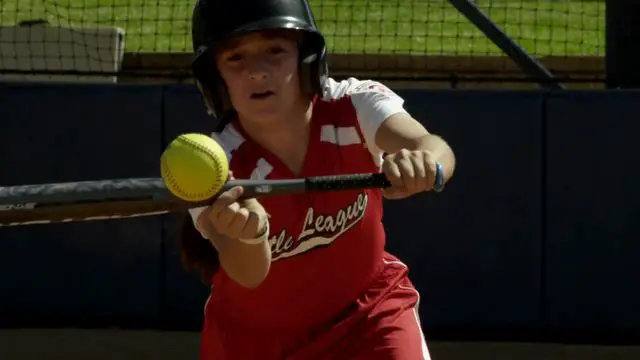There are many types of ways to hit a pitch in softball, some of which are bunts. This is a guide to help you understand the mechanics of how to bunt in softball, as well as the benefits that a bunt has in a game.
Whether you are new to softball or simply want to learn how to bunt more efficiently, this is the guide for you.
What is a bunt?
In softball, a bunt is when the batter on the plate hits the ball whilst maintaining a loose grip on the bat with their hands. This may seem counterintuitive, but it is a very tactical play.
The ball will bounce off the bat and into the infield area, away from the deep fielders. If a bunt is done correctly, the ball will move slowly to the desired area, causing even more issues for the fielders of the opposing team.

Why is a bunt beneficial to the game?
The reason that hitting a bunt in softball can be beneficial to the game is because the way that the ball is hit into play will cause confusion in the other team’s fielders.
If the fielders are fumbling for the ball when it lands somewhere that they did not expect, this gives the batting team’s runners a chance to run to the next base since the ball will take longer to get to the pitching mound.
There are a few different types of bunt in softball, so we will section them off below:
Swinging bunt
This is a product of a batter not intending to bunt but getting a similar outcome as a bunt. This will happen if the batter’s grip on the bat is not as loose as it would be for a normal bunt, but the swing will still be visible.
This type of bunt can also be used as a tactical type of bunt. If a batter swings as if they are going to hit the ball normally and then loosely hits it, this is known as a slug. A slug hit will throw the fielders off because they will be expecting a big hit due to the appearance of the swing leading up to the hit.
Bunting for a base hit
Next is a different type of bunt. A bunt hit is not always used to allow the runners to run further thanks to the fielders’ confusion. Bunting for a base hit involves bunting in order to advance to first base.
Only when the ball leaves the pitcher’s hands will the batter align themselves ready to hit a bunt. A drag bunt is when the hitter bunts the ball and immediately runs to first.
This is a technique more commonly used by left-handed batters because the angle allows them to already be close to first base as they ready themselves for the bunt hit.
When should I hit a bunt for base hit?
This depends on the situation of the field. Usually a bunt for a base hit will tend to happen at either 0 or 1, this is because this is the time in the game when the opportunity to make the run for first base will be more profitable.
Sacrifice bunt
A sacrifice bunt will usually occur when a runner needs to get from first base to second base. The batter on the plate will hit a sacrifice bunt that will usually result in them getting out, thus sacrificing themselves so that the runner can advance to second base. This is also the case if the runner needs to complete a homerun or even advance to any of the bases.
Because of the sacrificing nature of this bunt hit, a batter will get into position before the pitcher has thrown the ball, since there is no illusion needed.
When should I hit a sacrifice bunt?
This heavily depends on the score closer to the end of the game. If your team is further behind the other team on the scores, then a sacrifice bunt might be on the cards for a batter on the plate.
If a tie is looking likely, then a sacrifice bunt may be even more beneficial.
How can I practice bunting?
Just like with any other part of the game, practicing in softball will make you better. Here we have broken down some different ways that you can practice, either on your own or with some of your teammates.
- Practicing alone: this is the most obvious one but practicing your bunting in a batting cage or even with someone pitching is the most effective way to practice bunting. Maintain a loose grip on the bat and keep your elbows bent to absorb the shock of the ball.
- Pair bunting: this is a classic dynamic between the pitcher and the batter. This will provide a better scope of practice because a human pitcher will produce more varied balls than a pitching machine. This will help you stay prepared to bunt any type of softball pitch.
